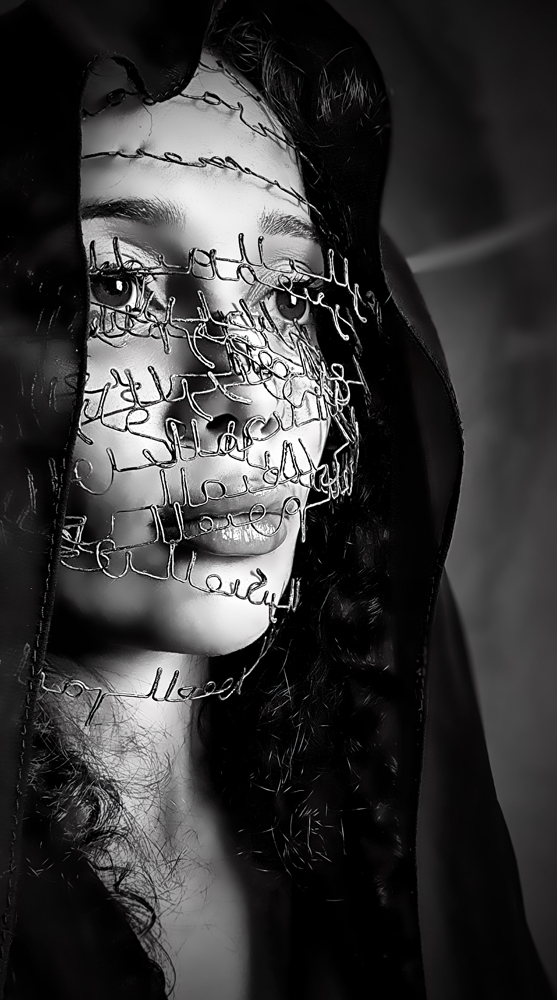Zohra
Hassani,
le corps
à l’œuvre.
Née à Paris en 1985, Zohra Hassani est diplômée de l’école d’Art Brassart de Tours dont elle sort majeure de sa promotion. Elle vit et travaille à Bordeaux.
Franco-Algérienne, en 1987, elle est forcée de retourner en Algérie, à Mostaganem. Sa mère est contrainte de la laisser auprès de sa grand-mère et de son arrière-grand-mère maternelle, deux figures marquantes de son enfance. Elle se plonge dès lors dans un mutisme quotidien et commence à dessiner. Aujourd’hui encore le dessin tient une place particulière dans son travail et constitue la phase préliminaire de tous ses travaux. Sa parole se dénoue à l’âge de 4 ans à son retour en France auprès de sa mère.
En 2023, après 16 ans d’éloignement, elle se rend en Algérie, à Oran, Tlemcen et Alger, pour y effectuer une résidence d’artistes. De là, elle explore ses racines et l’Histoire de l’Algérie, dont la découverte constitue un tournant dans son travail.
Artiste performeuse, elle développe une œuvre à la fois complexe et subtile. Elle n’hésite pas à engager son corps, tantôt relais d’une perception biaisée que nous renvoyons au monde tantôt vecteur privilégié de nos engagements, de nos peurs, de nos
héritages. En somme, le fruit de nos inconscients. Dans son œuvre, elle déploie tout un éventail de questions autour des violences intimes et collectives, des traumas.
Ainsi, ses influences sont vastes ; de la psychanalyse au surréalisme, du symbolisme à la philosophie soufie, de Fanon aux grandes féministes du siècle. Sa rencontre avec l’œuvre de Kandinsky est marquante. L’abstraction la fascine. Plus tard, elle découvre l’œuvre de Khadda et de Benanteur, eux aussi originaires de Mostaganem, dont la parenté se manifeste par le travail avec les symboles et la calligraphie.
Très sensible à la question des femmes, elles sont omniprésentes dans son travail. En effet, lorsque l’artiste engage son corps, le met en valeur, le malmène, le cache ou le dévoile, elle rend hommage à la femme dans ce qu’elle symbolise, représente, incarne.
Porteuses de mémoire (s), passeuses, elles s’érigent en figure de résistance et de résilience. Une nécessité impérieuse habite l’œuvre de Zohra Hassani : celle de leur donner corps, substance et matière.
Fadila Yahou | Historienne et critique d’art, docteure en histoire de l’art.

ولدت زهراء حساني، وهي من جنسيَّة فرنسية جزائرية، بباريس عام 1985، حازت على شهادة من مدرسة الفن براسار في تور، حيث تخرجت على المرتبة الأولى بدفعتها. وهي تعيش في بوردو وتعمل بها.
اضطرت، عام 1987، للعودة إلى الجزائر، إلى مستغانم بالتحديد. كانت والدتها مجبرة على تركها مع جدَّتها وجدتها الكبرى، وهما شخصيتان وضعتا بصماتهما فيها بمرحلة طفولتها. ومنذ ذلك الحين، دخلت في صمت يومي وبدأت في الرسم. اليوم، لا يزال الرسم يشغل مكانة خاصة في أعمالها ويشكل المرحلة الأولية لجميع أعمالها. ثمَّ ما لبثت أن اِنفكَّت عقدة لسانها وهي في سن الرابعة عندما عادت إلى فرنسا بحضن والدتها.
في عام 2023، وبعد 16 عامًا من الغربة، قدمت إلى الجزائر، حيث زارت وهران وتلمسان والجزائر العاصمة، للقيام بإقامة فنية. من هناك، استكشفت جذورها وتاريخ الجزائر، وهو ما شكَّل نقطة تحوُّل في أعمالها.
وإذا كانت زهراء حساني فنانة تعتمد على فنِّ الأداء، فإنَّهت تطور عملاً معقدًا ودقيقًا في الوقت ذاته. فهي لا تتردد في استخدام جسدها، سواء كوسيلة لتوصيل رؤية مشوهة للعالم أو كأداة للتعبير عن مواقفنا ومخاوفنا وموروثنا؛ ممَّا يشكِّل في الأخير ثمرة اللَّاوعي فينا. في أعمالها، تطرح مجموعة واسعة من الأسئلة حول العنف الشخصي والجماعي، والصدمات.
تتأثر أعمالها بتنوع واسع في المصادر؛ من التحليل النفسي إلى السريالية، ومن الرَّمزية إلى الفلسفة الصُّوفية، ومن فانون إلى كبار النِّسويات في القرن. كان لها مع أعمال كاندينسكي لقاءٌ مؤثِّرٌ، حيث صارت التَّجريدية تأسرها. اكتشفت لاحقًا أعمال خدَّة وبن عنتر، وهما أيضًا من مستغانم، حيث تجلَّت صلة القرابة معهما من خلال العمل بالرموز والخط.
تمتلك زهراء حساني حساسيَّةً كبيرةً لقضايا النساء، فهنَّ حاضرات بشكل دائم في أعمالها. فعندما تستخدم الفنَّانة جسدها، تعرضه، تتلاعب به، تخفيه أو تكشفه، فإنَّها تكرم المرأة في ما تمثِّله وتحتوي عليه.
وإذا كنَّ حاملات للذَّاكرة، وناقلات لها، فإنَّهن يصبحن رمزًا للمقاومة والمرونة. توجد ضرورة ملحَّة تتجسَّد في أعمال زهراء حساني، وهي أنَّ تعطي لأجسادهنَّ ماهيَّتها وجوهرها.
فاضلة ياهو | مؤرخة وناقدة فنية، دكتورة في تاريخ الفنّ.
زهراء
حساني
الجسم في
ورشة
Zohra
Hassani,
the body
in ACTION.
Born in Paris in 1985, Zohra Hassani graduated top of her class from the Brassart art school in Tours. She lives and works in Bordeaux.
French-Algerian, she was forced in 1987 to return to Algeria, in the city of Mostaganem. Her mother was forced to leave her with her grandmother and maternal great-grandmother, two key figures in her childhood. From then on, she plunged into a daily silence and began to draw. Drawing still holds a special place in her work today, and forms the preliminary phase of all her works. At the age of 4, she returned to France to live with her mother.
In 2023, after 16 years away from home, she went to Algeria, to Oran, Tlemcen and Algiers, for an artist residency. From there, she explored her roots and the history of Algeria, the discovery of which marked a turning point in her work.
A performer artist, her work is both complex and subtle. She never hesitates to engage her body, sometimes relaying our skewed perception of the world, sometimes a privileged vehicle for our commitments, our fears, our heritages.
heritage. In short, the fruit of our unconscious. In her work, she explores a whole range of issues surrounding intimate and collective violence and trauma.
Her influences are vast, from psychoanalysis to surrealism, from symbolism to Sufi philosophy, from Fanon to the great feminists of the century. Her encounter with the work of Kandinsky was a turning point. Abstraction fascinated her. Later, she discovered the work of Khadda and Benanteur, also from Mostaganem, whose kinship can be seen in their work with symbols and calligraphy.
Very sensitive to women’s issues, they are omnipresent in his work. Indeed, when the artist engages her body, highlights it, mishandles it, hides it or reveals it, she pays homage to women in what they symbolize, represent and embody.
As bearers of memory(s) and passers-by, they are figures of resistance and resilience. Zohra Hassani’s work is driven by a compelling need to give them body, substance and matter.
Fadila Yahou | Art historian and critic, PhD in art history.



